St. John the Baptist Byzantine Catholic Church
Minneapolis, Minnesota
Compiled by, Father Ihar Labacevich
TCC wishes to extend a special thank you to Father Ihar Labacevich for offering the history and photos of his parish.
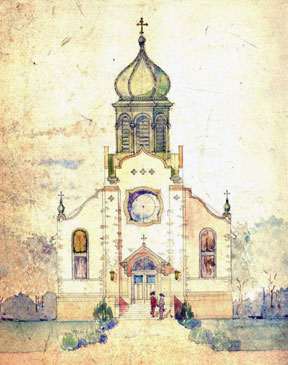 The second half of the 19th – beginning of the 20th centuries were the times when many Slavic people came to America trying to avoid hardships of life in the disintegrating Austro-Hungarian empire. Millions of Czechs, Poles, Ukrainians, Slovaks, Hungarians left their family homes looking for better life. Most of these people were Roman Catholics, small number of them were Protestants. Among them, there was also a group of people who belonged to the Eastern Catholic Church still known in Europe as Greek Catholic and in America as Byzantine Catholic and Ukrainian Catholic Churches. These people came from the Eastern part of the Hapsburg Empire, a small corner of Europe which is divided today between Ukraine, Slovakia, Hungary and Poland and situated on the both sides of the Carpathian mountains, i.e. from the regions known today as Transcarpathia and Galicia. Their self-identification was different from region to region, they were usually called by regional names, such as Rusyns, Ruthenians, Lemkos, Carpatho-Ukrainians, Rusnaks, etc.
The second half of the 19th – beginning of the 20th centuries were the times when many Slavic people came to America trying to avoid hardships of life in the disintegrating Austro-Hungarian empire. Millions of Czechs, Poles, Ukrainians, Slovaks, Hungarians left their family homes looking for better life. Most of these people were Roman Catholics, small number of them were Protestants. Among them, there was also a group of people who belonged to the Eastern Catholic Church still known in Europe as Greek Catholic and in America as Byzantine Catholic and Ukrainian Catholic Churches. These people came from the Eastern part of the Hapsburg Empire, a small corner of Europe which is divided today between Ukraine, Slovakia, Hungary and Poland and situated on the both sides of the Carpathian mountains, i.e. from the regions known today as Transcarpathia and Galicia. Their self-identification was different from region to region, they were usually called by regional names, such as Rusyns, Ruthenians, Lemkos, Carpatho-Ukrainians, Rusnaks, etc.
Church was always one of the most important constituting parts of their identity – back home and in America. However, there was no bishop, no church administrator for the Greek-Catholics in North America at that time, no one to help them to organise their religious life. So, people started organising their parishes and building their churches themselves from the early days of immigration to the USA. After their arrival to the USA, they settled down in different parts of the country, including New York, New Jersey, Pennsylvania, Ohio and Minnesota. Most of them had little education and virtually no knowledge of English. The only work available in America for them was hard labour in mines, mills and quarries. Most of them found employment in mining and steel industries. In Minnesota some of them became workers of the local flour mills and railways. Despite the poverty immigrants set aside money to build their own churches and schools, they organised lodges for fraternal, social and economic benefits.
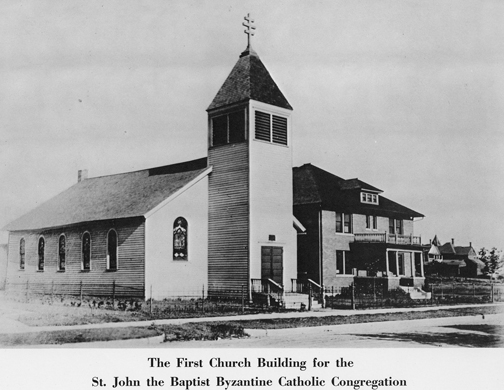 The first Ruthenian priest in America was Fr. Ivan (John) Wolansky, native of Galicia. He was sent to the USA as a missionary priest by the Major Archbishop of Lviv Sylvester Sembratovich and arrived to America in 1884 together with his wife. Initially he came to the mining town Shenandoah in Pennsylvania where on the 19th of December 1884 in extremely modest conditions of the private home he offered the first Eastern Catholic Divine Liturgy in America. Fr. Wolansky visited Minneapolis several times. As a fruit of his visits the first Greek-Catholic parish in Minneapolis was founded in 1887 and blessed by Fr. Wolansky in 1889. This parish was known as St. Mary’s Greek-Catholic Church in Minneapolis.
The first Ruthenian priest in America was Fr. Ivan (John) Wolansky, native of Galicia. He was sent to the USA as a missionary priest by the Major Archbishop of Lviv Sylvester Sembratovich and arrived to America in 1884 together with his wife. Initially he came to the mining town Shenandoah in Pennsylvania where on the 19th of December 1884 in extremely modest conditions of the private home he offered the first Eastern Catholic Divine Liturgy in America. Fr. Wolansky visited Minneapolis several times. As a fruit of his visits the first Greek-Catholic parish in Minneapolis was founded in 1887 and blessed by Fr. Wolansky in 1889. This parish was known as St. Mary’s Greek-Catholic Church in Minneapolis.
The first pastor of that parish was Fr. Alexis Toth, a widower and former professor of the seminary in Pryashiv (Preshov – now a city within contemporary Slovakia borders). The American Latin rite bishops did not know anything about other Catholic churches besides their own of the Latin rite. Their understanding of the universality of the Catholic Church was very often limited to only one Latin tradition. As a result of such an attitude of the Latin hierarchy a rather unpleasant and humiliating to the Eastern Catholics exchange between Fr. Alexis and archbishop of St. Paul John Ireland happened, which led to the decision of 361 member of that parish to join the Russian Orthodox Church in on the March 25, 1891. Their church in Minneapolis became “Greek-Catholic Russian Orthodox Church of the All-holy Theotokos and Ever-Virgin Mary” and known today as St. Mary’s Orthodox Cathedral of the Orthodox Church in America (OCA). About 20 thousand Greek-Catholics all over America followed their example and formed seventeen Orthodox parishes, which later became a foundation of the Orthodox Church in America.
However, not all the members of the St. Mary’s Church joined Orthodoxy. During the next decade some new immigrants came from the Carpathians and Galicia, who, together with the rest of the former parishioners of St. Mary’s church who remained faithful to their Eastern Catholic heritage, wanted to organise their own Catholic parish. On March 30, 1902, a meeting was held which was attended by a group of people who founded “The Brotherhood of St. John the Baptist” later evolved into the “St. John’s Greek Catholic Lodge No. 300”. A very significant development in the history of the Eastern Catholic Church in America happened on March 8, 1907, when Fr. Soter Ortynsky OSBM was appointed a bishop for the Ruthenians in America and named a titular bishop of Daulia by Pope Pius X. As the head of the Ukrainian Catholic Church Patriarch Lubomyr Husar said in his homily on the occasion of the 100th Anniversary of the arrival of Bp. Soter to the United States, “His task was two-fold. First, … to establish ecclesiastical structure to organize ecclesiastical life for the immigrants … to help them spiritually. But he also had a different task, to explain to his brother bishops of the Latin Rite, the local bishops here, who were these immigrants who, although they insisted that they were Catholics, had a different tradition, different culture, different liturgical rite, were so different in many ways. So different that it seemed impossible to integrate them into the American life. His task was also to explain who these people were”.
With bishop Soter’s blessing members of the GCU Lodge 300 in Minneapolis purchased five lots of land and a wooden church building, which they moved from a different location. On the Thanksgiving day, November 28, 1907, the first Divine Liturgy was celebrated in Minneapolis in the newly opened St. John the Baptist Ruthenian Greek Catholic Church by the first pastor of this parish Fr. J.A. Zaklynsky. The first member of the new parish was baptised and chrismated on November 24 of the same year – Anna Antonyak. At its founding in 1907, the parish consisted of 18 founding families with an average age of under 30 for the heads of the households. By the end of 1908 there were already 93 families in the parish and then gradually rose to 124 in 1923.
Father Zaklynsky was succeeded in the beginning of 1908 by Fr. Volodymyr Stech. In May 1908 His Grace Bishop Soter blessed the church during his visit to Minneapolis. On the June 8, 1908 the Articles of Incorporation were signed by archbishop John Ireland, bishop Soter Ortynsky and Fr. Volodymyr Stech. Thus, St. John the Baptist Ruthenian Greek Catholic Church in Minneapolis became officially established as “associated with” the local Roman Catholic bishop, i.e. as a Roman Catholic parish.
There were internal difficulties within the Ruthenian Greek-Catholic Church in America arising from the differences between Ruthenians from Galicia and Ruthenians from Transcarpatia. The former group, which became later known as Ukrainians, had a different vision of their ethnicity as an independent nation and, therefore, also different goals from the latter, Carpatho-Rusyn group, which was more influenced by Hungarian culture and politics. There were about 20 families with strong Ukrainian identity among the members of St. John’s parish. Even among the clergy - some of the priests were from Galicia, others from Transcarpathia. For instance, among the priests serving at St. John’s between 1907 and 1915, Fr. John Zaklynsky, Fr. Volodymyr Stech were from Galicia, Fr. Oleksa, Fr. A. Vajda and Fr. J. Kovacs – from the Transcarpatian region. Even the fact that these two groups had identical liturgical traditions and were able to communicate without an interpreter did not contribute much to the preservation of unity. Bishop Soter appointed in 1912 a new pastor to St. John’s parish, Fr. Constantine Kuryllo, a married man and native of Galicia. Some people in the parish did not accept this priest only for the reasons of his origins. As a result, the first split occurred in 1912 when St. Constantine’s Greek-Catholic Church was founded in Minneapolis, just a mile away from St. John’s. For the next almost three years, as St. John’s church records show, there was no priest assigned to St. John’s parish. All baptisms, chrismations, marriages and funerals of that period, including that of the late Archbishop Stephen Kocisko, took place at St. Constantine’s parish until Fr. Jason Kovacs, who was a pastor of St. John’s before Fr. Kuryllo’s appointment in 1912, was sent by bishop Soter back to Minneapolis.
On the national scale the same sad split happened when Bishop Soter Ortynsky died in 1916. Bishop Soter being of Ukrainian descent himself, nevertheless wanted all Greek Catholic in USA to be together and to overcome their regional differences. However, after his death, the ecclesiastical authorities in Rome decided to divide Greek Catholics in America and create separate Exarchates for Ukrainians in Philadelphia and for Transcarpathians in Pittsburgh. The administrators-priests headed both Exarchates until Bishop Constantine Bohachevsky was appointed for Ukrainians and Bishop Basil Takach for the Ruthenians from Transcarpathia on the May 8, 1924.
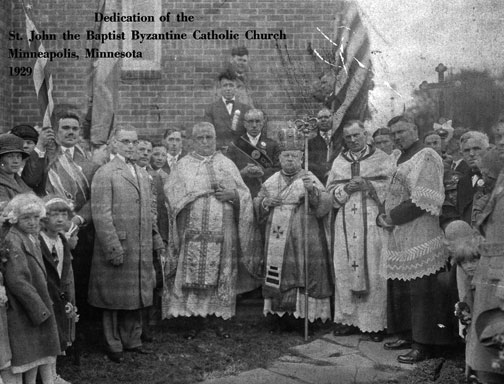 By the 1920s growing St. John’s congregation could not fit anymore in a small wooden church building they initially purchased. The building of the new church begun in 1923 and was completed in 1927. Fr. John Bihary celebrated the first liturgy in the new church in May of 1927. This new church was splendidly decorated, but it’s decoration was that of the Roman tradition rather than Byzantine. Except for the traditional three bar cross there were no other “Eastern” elements in the church interior. It can be partially understood if we look at the dynamic of development of the Ruthenian church in America. By that time immigration from Europe was virtually stopped. In the period between 1907 and 1927 several generations of parishioners already were brought up in America. Those people have never been to Europe, their home was now in Minnesota, not in Carpathians. More and more people of St. John started loosing their Ruthenian identity. By 1940 most of them were already speaing English as their first language. The whole cultural situation in the United States pointed towards “Americanisation”, i.e. a process of total assimilation of the minority cultures. Languages and customs of the first generations of immigrants were replaced by that of mainstream American, which often meant in the situation of the Eastern Catholic churches simply Roman Catholic and English speaking culture. Post-Second World war politics of McCarthyism also contributed to this negative process of assimilation. Byzantine Catholics were afraid of being accused in any pro-Russian and, therefore, pro-communist sentiment. The easiest way to get rid of these accusations was to become “more American” at the expense of their own identity. During the time of Bishop N. Elko, who was an advocate of this “Americanisation”, many traditional Byzantine architectural features, such as iconostasis (icon screens), were omitted or removed from the new or renovated churches, western style pews and other elements were added. As a positive development of that time one can mention the fact that English became an official language of the Ruthenian Church and that the ecclesiastical status of the Exarchate was elevated to that of the Eparchy, i.e. independent self-governing church.
By the 1920s growing St. John’s congregation could not fit anymore in a small wooden church building they initially purchased. The building of the new church begun in 1923 and was completed in 1927. Fr. John Bihary celebrated the first liturgy in the new church in May of 1927. This new church was splendidly decorated, but it’s decoration was that of the Roman tradition rather than Byzantine. Except for the traditional three bar cross there were no other “Eastern” elements in the church interior. It can be partially understood if we look at the dynamic of development of the Ruthenian church in America. By that time immigration from Europe was virtually stopped. In the period between 1907 and 1927 several generations of parishioners already were brought up in America. Those people have never been to Europe, their home was now in Minnesota, not in Carpathians. More and more people of St. John started loosing their Ruthenian identity. By 1940 most of them were already speaing English as their first language. The whole cultural situation in the United States pointed towards “Americanisation”, i.e. a process of total assimilation of the minority cultures. Languages and customs of the first generations of immigrants were replaced by that of mainstream American, which often meant in the situation of the Eastern Catholic churches simply Roman Catholic and English speaking culture. Post-Second World war politics of McCarthyism also contributed to this negative process of assimilation. Byzantine Catholics were afraid of being accused in any pro-Russian and, therefore, pro-communist sentiment. The easiest way to get rid of these accusations was to become “more American” at the expense of their own identity. During the time of Bishop N. Elko, who was an advocate of this “Americanisation”, many traditional Byzantine architectural features, such as iconostasis (icon screens), were omitted or removed from the new or renovated churches, western style pews and other elements were added. As a positive development of that time one can mention the fact that English became an official language of the Ruthenian Church and that the ecclesiastical status of the Exarchate was elevated to that of the Eparchy, i.e. independent self-governing church.
Two other changes in the 1930s and 1940s hit St. John’s parishioners hard: first, the Pittsburgh Exarchate began enforcing the celibacy rule for priests as it was envisaged by the papal decree Cum Data Fuerit (1929). A group of priests of the Ruthenian Exarchate dissatisfied by this document gathered together and elected pastor in Bridgeport, CT, Father Orestes Chornock a Bishop of a new Independent Greek Catholic Church. He was consecrated a bishop by the Patriarch of Constantinople, eventually setting his See in Johnstown, PA. This would, in time, be known as The American Carpatho-Russian Orthodox Greek Catholic Diocese. Then, in the 1940s, St. John’s was ordered to adopt the "new" Gregorian calendar instead of the traditional Julian (in the 20th Century, it was 13 days behind the Gregorian). In 1941 a small number of families formed St. Nicholas Carpatho-Russian Greek Catholic Church just two blocks away from St. John’s. This church, however, did not exist for a long time and some of its members came back to St. John’s, while others joined St. Mary’s Orthodox Church.
II World war shaped the 1940s of St. John’s. A good number of men in the congregation served in the armed forces and some of them were killed in the war. After the war a lot of the veterans came back to Minneapolis hoping to find jobs, get married and settle down in North East, where their families lived. However, due to the demographic changes in post-war United States, many of them had to move out of the North East Minneapolis. Moreover, many people married spouses who were not Byzantine Catholics. As a result of these and other factors the membership of St. John suffered considerable decline during that period of time.
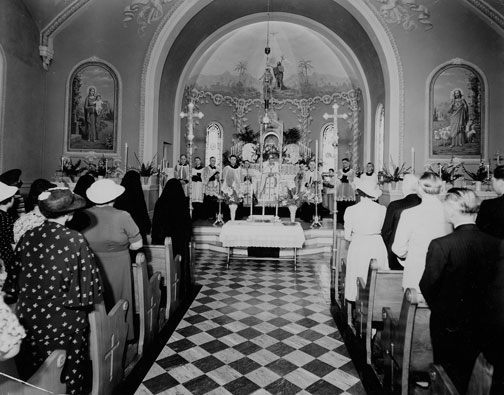 On the other hand, the1960s was a time when the II Vatican Council opened Catholic Church to the “outside” world and also brought a lot of positive changes to the Eastern Catholicism. Thus, the Eastern Catholic Churches were officially recognised as the Churches of their own right, not as merely subdivisions of the Roman Catholicism. Since its inception in 1924 as the "Apostolic Exarchate of United States of America, Faithful of the Oriental Rite (Ruthenian)", the organizational status of the Church was merely that of a missionary territory with limited self-governing authority, the homeland being Europe—albeit under Communist persecution since 1946. On July 6, 1963 the Vatican upgraded the status of the church from Exarchate to Eparchy, or diocese according the Latin-Rite terminology. A decree by the newly elected Pope Paul VI divided the entire U.S. territory of the Church into two separate ecclesiastical jurisdictions. The first, the Byzantine Catholic Eparchy of Passaic, included the Eastern states and the second jurisdiction, centred in Pittsburgh, included the rest of the nation. Both jurisdictions now held the canonical status of an eparchy or a full diocese. Bishop Elko continued as the American Church's senior hierarch, but one of the former parishioners of the St. John’s parish, Stephen J. Kocisko, was selected as the first bishop for Passaic and was installed on July 6, 1963 and later on, after Archbishop N. Elko’s resignation, he was installed as Archbishop of Pittsburgh on March 3, 1968. In 1969, St. John’s parent eparchy has been switched from Pittsburgh to the newly established Eparchy of Parma, Ohio. The whole Ruthenian church thus became an autonomous Metropolitan church.
On the other hand, the1960s was a time when the II Vatican Council opened Catholic Church to the “outside” world and also brought a lot of positive changes to the Eastern Catholicism. Thus, the Eastern Catholic Churches were officially recognised as the Churches of their own right, not as merely subdivisions of the Roman Catholicism. Since its inception in 1924 as the "Apostolic Exarchate of United States of America, Faithful of the Oriental Rite (Ruthenian)", the organizational status of the Church was merely that of a missionary territory with limited self-governing authority, the homeland being Europe—albeit under Communist persecution since 1946. On July 6, 1963 the Vatican upgraded the status of the church from Exarchate to Eparchy, or diocese according the Latin-Rite terminology. A decree by the newly elected Pope Paul VI divided the entire U.S. territory of the Church into two separate ecclesiastical jurisdictions. The first, the Byzantine Catholic Eparchy of Passaic, included the Eastern states and the second jurisdiction, centred in Pittsburgh, included the rest of the nation. Both jurisdictions now held the canonical status of an eparchy or a full diocese. Bishop Elko continued as the American Church's senior hierarch, but one of the former parishioners of the St. John’s parish, Stephen J. Kocisko, was selected as the first bishop for Passaic and was installed on July 6, 1963 and later on, after Archbishop N. Elko’s resignation, he was installed as Archbishop of Pittsburgh on March 3, 1968. In 1969, St. John’s parent eparchy has been switched from Pittsburgh to the newly established Eparchy of Parma, Ohio. The whole Ruthenian church thus became an autonomous Metropolitan church.
Vatican II Council also called Byzantine Catholics to rediscover their roots. On the local level of the St. John’s parish Fr. Basil Shereghy, who became a pastor of St. John’s in 1957, was instrumental in this task. A former professor of the seminary in Uzhorod, he emigrated to America in 1946. He worked as a professor of language and liturgy at the Byzantine Catholic Seminary of SS. Cyril and Methodius in Pittsburgh, Pennsylvania. He was also the founding associate editor and longtime editor (1970-1986) of the diocesan newspaper Byzantine Catholic World. Author of many books on history and traditions of the Byzantine Catholicism, he greatly contributed to the renewal of St. John’s parish. During his pastorate the beautiful wall and ceiling paintings were done in the church. Revival of the Byzantine traditions is a long and difficult process, which often meets people’s reluctance and lack of appreciation. Being unable to restore the full traditional iconostasis due to the particular circumstances of that period of our history, Fr. Basil introduced side panels with icons, which later, in 1980-90s became parts of our present icon screen, restored by Fr. Bryan Eyman. In 1995 the icon screen was finally completed and a baptismal font was acquired by Fr. Edward Wojciechowski.
During the 1980s St. John’s again suffered a loss of many parishioners, who left the church following a scandal involving the pastor. After the short term of two other priests, Fr. Bryan Eyman became St. John’s pastor in 1988. He initiated various outreach programmes, trying to bring new people to St. John’s church. Despite the strong opposition among the parishioners to his attempts to bring back lost heritage and open the parish to the outside world, Fr. Bryan succeeded in restoring the church interior in a traditional Byzantine way. Once again it became possible for people of St. John’s to worship God according to genuine customs of their ancestors. On the November 1, 1992 a solemn re-dedication of St. John the Baptist Byzantine Catholic Church took place. Looking at these events, we may conclude, that although our parish lost some people following Ruglovsky’s incident, our return to the Byzantine tradition helped us to gain new families interested in our heritage.
One of the important roles in the Byzantine liturgy is that of the deacon. Only recently our church started revival of this noble tradition. Thus, Mr. Justin J. O’Connell, a parishioner of St. John’s was ordained to diaconate in June 1995 by then eparch of Parma Bp. A. Pataki. Unfortunately, being ordained already at the age of 78, Deacon Justin is no longer with us.
St. John’s is the only English-speaking Byzantine Catholic church in Minnesota. Currently we have in our parish people coming to our services from places situated as far as South Dakota.
Another aspect of St. John’s life is worth noting – a contribution of St. John’s people to the social and cultural life of North East Minneapolis. Throughout its history the parish hosted annual balls, folk and church choir music concerts. Today many of our parishioners contribute their skills and time to organise our annual Rummage sale and Fall festival. There are potlucks on several Sundays of the year, which give people a possibility to enjoy traditional Slavic and Hungarian cooking.
Today, St. John’s parish, recounting past 100 years of its existence, stands grateful to God for many blessings that we received from Him during all these years. We especially thank God for the possibility to overcome many problems and difficulties encountered by our parish. Our 100 years journey wasn’t easy, but people of St. John’s succeeded in preserving what their ancestors started in 1907. We also ask God to grant the descendants of our parishioners 100 years from now have the same dedication and faithfulness as the founders of our parish had 100 years ago. God grant us another 100 years!
Early Photos of Ladies & Men's Societies of St. John's Byzantine Catholic Church
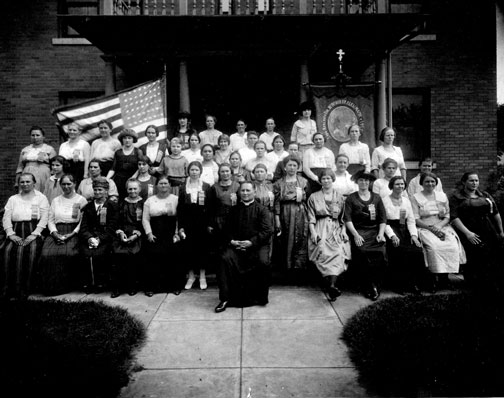
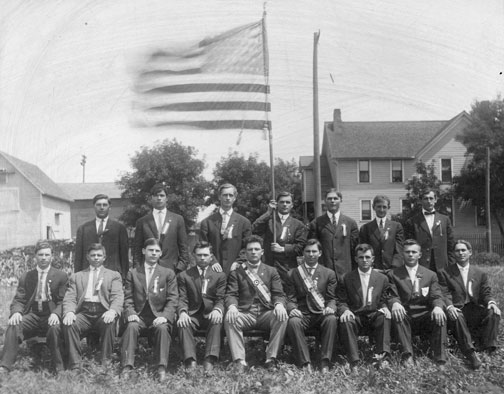
St. John the Baptist Byzantine Catholic Church (Official Site)



